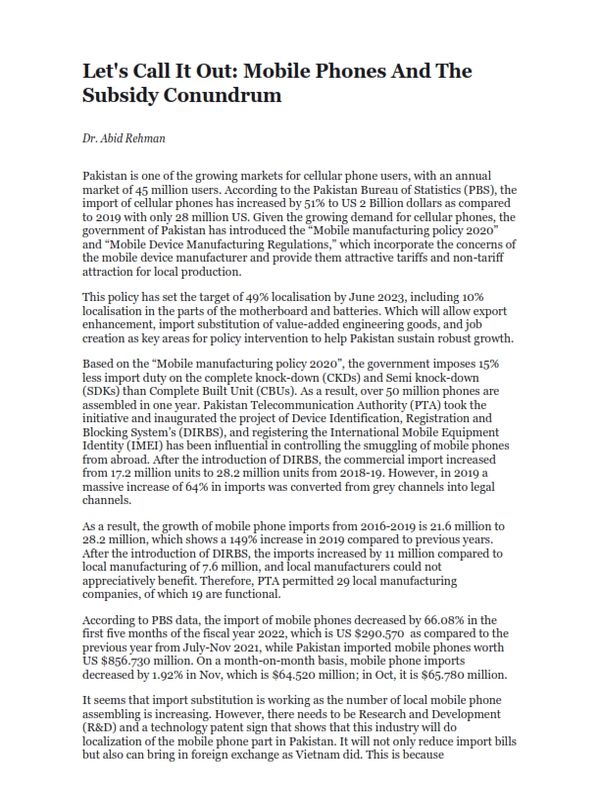
Pakistan Institute of Development Economics
- Home
Our Portals
MenuMenuMenuMenuMenuMenuMenu - ResearchMenuMenuMenuMenuMenuMenuMenu
- Discourse
- The PDR
- Our Researchers
- Academics
- Degree Verification
- Thesis Portal
- Our Portals
Let’s Call It Out: Mobile Phones And The Subsidy Conundrum
It may appear that the mobile phone import substitution is working as the number of local mobile phone assembling is increasing but in fact there has been no impact of import substitution policies on mobile manufacturing
Pakistan is one of the growing markets for cellular phone users, with an annual market of 45 million users. According to the Pakistan Bureau of Statistics (PBS), the import of cellular phones has increased by 51% to US 2 Billion dollars as compared to 2019 with only 28 million US. Given the growing demand for cellular phones, the government of Pakistan has introduced the “Mobile manufacturing policy 2020” and “Mobile Device Manufacturing Regulations,” which incorporate the concerns of the mobile device manufacturer and provide them attractive tariffs and non-tariff attraction for local production.
This policy has set the target of 49% localisation by June 2023, including 10% localisation in the parts of the motherboard and batteries. Which will allow export enhancement, import substitution of value-added engineering goods, and job creation as key areas for policy intervention to help Pakistan sustain robust growth.
Based on the “Mobile manufacturing policy 2020”, the government imposes 15% less import duty on the complete knock-down (CKDs) and Semi knock-down (SDKs) than Complete Built Unit (CBUs). As a result, over 50 million phones are assembled in one year. Pakistan Telecommunication Authority (PTA) took the initiative and inaugurated the project of Device Identification, Registration and Blocking System’s (DIRBS), and registering the International Mobile Equipment Identity (IMEI) has been influential in controlling the smuggling of mobile phones from abroad. After the introduction of DIRBS, the commercial import increased from 17.2 million units to 28.2 million units from 2018-19. However, in 2019 a massive increase of 64% in imports was converted from grey channels into legal channels.
As a result, the growth of mobile phone imports from 2016-2019 is 21.6 million to 28.2 million, which shows a 149% increase in 2019 compared to previous years. After the introduction of DIRBS, the imports increased by 11 million compared to local manufacturing of 7.6 million, and local manufacturers could not appreciatively benefit. Therefore, PTA permitted 29 local manufacturing companies, of which 19 are functional.
According to PBS data, the import of mobile phones decreased by 66.08% in the first five months of the fiscal year 2022, which is US $290.570 as compared to the previous year from July-Nov 2021, while Pakistan imported mobile phones worth US $856.730 million. On a month-on-month basis, mobile phone imports decreased by 1.92% in Nov, which is $64.520 million; in Oct, it is $65.780 million.
It seems that import substitution is working as the number of local mobile phone assembling is increasing. However, there needs to be Research and Development (R&D) and a technology patent sign that shows that this industry will do localization of the mobile phone part in Pakistan. It will not only reduce import bills but also can bring in foreign exchange as Vietnam did. This is because conglomerates in Pakistan are chasing subsidies. They are gaining enough profit in assembling due to unconditional subsidy on mobile phone assembling. Therefore, there is no incentive to do R&D or bring in foreign direct investment.
According to PIDE recent research, most targets are not accomplished if we critically evaluate the policy. For example, the target of this policy was to achieve 49 percent localization, including 10 percent localization of parts of the motherboard and 10 percent localization of batteries by June 2023. But, till now, no part of the motherboard and batteries are being prepared in Pakistan except for a few casings, and there is no production of parts locally.
Secondly, the target was to create half a million jobs for unemployed people, but only 20,000 jobs were created.
Thirdly the policy also targets the 200,000 export of locally assembled mobile phones to other countries like Africa, Central Asian Republics, and Afghanistan. Still, only 16,000 phones are exported to UAE.
Lastly, the policy aims to lower the price of mobile handsets, and the availability of cheaper phones will increase smartphone penetration in the country. Failure of these policies and historical trends show that import substitution policies always have adverse effects, leading to higher prices and reduced consumer choice. In addition, domestic industries may not be as efficient or competitive as their foreign counterparts, leading to lower-quality products and reduced international competitiveness.
In conclusion, there is no impact of import substitution policies on mobile manufacturing in Pakistan, as this policy needs to achieve the core objective of reducing import bills and making the industry export. Instead, the conglomerates are chasing subsidies. So, there is a need to link the support in the form of subsidies with research and development and localization to make policy more effective rather than blindly giving subsidies.



